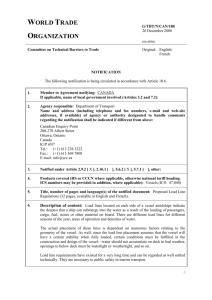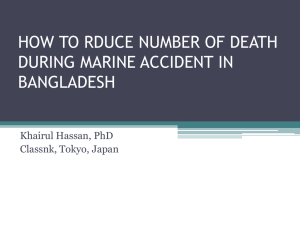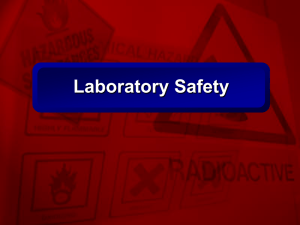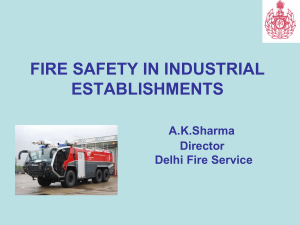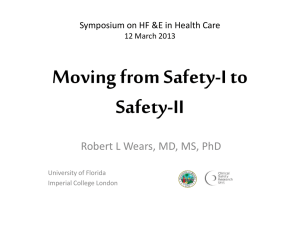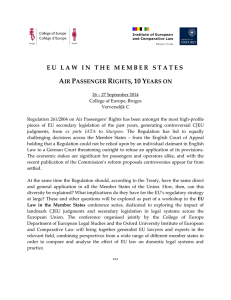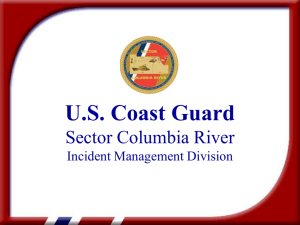Analysis of Bangladesh Accidents: A Decision
advertisement
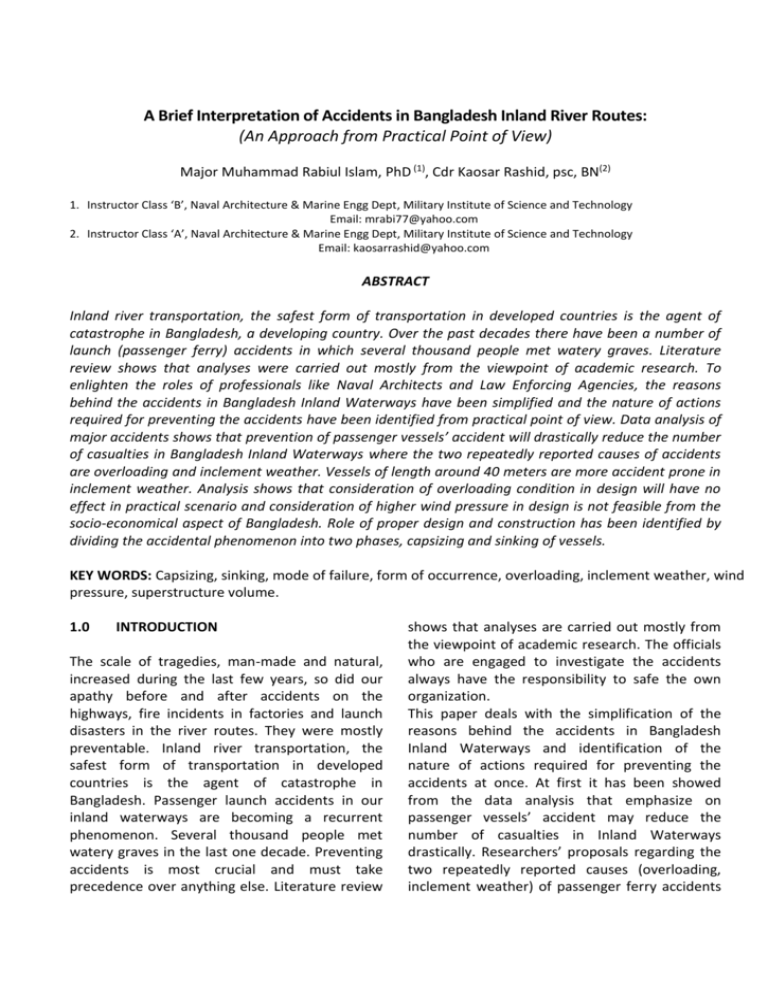
A Brief Interpretation of Accidents in Bangladesh Inland River Routes: (An Approach from Practical Point of View) Major Muhammad Rabiul Islam, PhD (1), Cdr Kaosar Rashid, psc, BN(2) 1. Instructor Class ‘B’, Naval Architecture & Marine Engg Dept, Military Institute of Science and Technology Email: mrabi77@yahoo.com 2. Instructor Class ‘A’, Naval Architecture & Marine Engg Dept, Military Institute of Science and Technology Email: kaosarrashid@yahoo.com ABSTRACT Inland river transportation, the safest form of transportation in developed countries is the agent of catastrophe in Bangladesh, a developing country. Over the past decades there have been a number of launch (passenger ferry) accidents in which several thousand people met watery graves. Literature review shows that analyses were carried out mostly from the viewpoint of academic research. To enlighten the roles of professionals like Naval Architects and Law Enforcing Agencies, the reasons behind the accidents in Bangladesh Inland Waterways have been simplified and the nature of actions required for preventing the accidents have been identified from practical point of view. Data analysis of major accidents shows that prevention of passenger vessels’ accident will drastically reduce the number of casualties in Bangladesh Inland Waterways where the two repeatedly reported causes of accidents are overloading and inclement weather. Vessels of length around 40 meters are more accident prone in inclement weather. Analysis shows that consideration of overloading condition in design will have no effect in practical scenario and consideration of higher wind pressure in design is not feasible from the socio-economical aspect of Bangladesh. Role of proper design and construction has been identified by dividing the accidental phenomenon into two phases, capsizing and sinking of vessels. KEY WORDS: Capsizing, sinking, mode of failure, form of occurrence, overloading, inclement weather, wind pressure, superstructure volume. 1.0 INTRODUCTION The scale of tragedies, man-made and natural, increased during the last few years, so did our apathy before and after accidents on the highways, fire incidents in factories and launch disasters in the river routes. They were mostly preventable. Inland river transportation, the safest form of transportation in developed countries is the agent of catastrophe in Bangladesh. Passenger launch accidents in our inland waterways are becoming a recurrent phenomenon. Several thousand people met watery graves in the last one decade. Preventing accidents is most crucial and must take precedence over anything else. Literature review shows that analyses are carried out mostly from the viewpoint of academic research. The officials who are engaged to investigate the accidents always have the responsibility to safe the own organization. This paper deals with the simplification of the reasons behind the accidents in Bangladesh Inland Waterways and identification of the nature of actions required for preventing the accidents at once. At first it has been showed from the data analysis that emphasize on passenger vessels’ accident may reduce the number of casualties in Inland Waterways drastically. Researchers’ proposals regarding the two repeatedly reported causes (overloading, inclement weather) of passenger ferry accidents have been discussed. Finally, this paper ends by discussing the role of proper design and construction in launch accidents and importance of following design criteria in voyage where an accidental phenomenon has been divided into two phases, capsizing and sinking. 2.0 BANGLADESH INLAND RIVER ROUTES Bangladesh, as a riverine country with 24,000 km waterways has a navigable network varying from 5968 km during the monsoon to 3865 km during the dry season. According to the traffic and economic importance, the inland waterways have been classified into four classes of routes [1]. Details of those classes of Bangladesh inland river routes are shown in Table 1. Class III and class IV routes are within the narrow channels. As In class I and class II routes vessels ply in full throttle and the effect of storm is most severe, most of the major accidents have occurred in class-I route and in class-II route. Table 1: Classification of Inland River Routes Route Class I Vessel can ply 12-13 with Draught (Ft) Approx. Length (Km) 3.0 2014 is partial. Statistics of death toll in waterways shows a large number of fishermen die each year due to sailing in bad weather. That toll has also been excluded from the data presented in this year to year comparison plot. 685 II 8 1000 III 6 IV 5 1885 2400 DATA ANALYSIS A year to year comparison of no. of deaths due to accidents in Bangladesh Inland Waterways has been plotted in figure 1. The data has been collected from BIWTA (Bangladesh Inland Water Transport Authority) which could not be verified. The data excluded the missing and injured, where in each accidents a large number remains missing forever. So the plot can only give a comparison of death toll intensity (not the exact no. of deaths) due to river accidents within the last consecutive ten years. It should be noted here that the data of Fig. 1: Year to year comparison of deaths in accidents in inland waterways In figure 1, the column height is comparatively greater in the year of 1994, 2002, 2003 and 2005. The reasons behind the relatively higher death number in those four years are the major accidents shown in Table 2. Table 2: Accident data of the year 1994, 2002, 2003 and 2005 Death in Total Vessel Reported Year single death (Type) Cause accident Turbulence M.V. Dinar – 2 1994 346 273 water & over (passenger) loading M.V. Salauddin -2 2002 281 245 Nor`wester (passenger) M.V. Mitali-3 131 Nor`wester (passenger) 2003 931 M.V. Nasrin-1 Turbulence water & over 625 (passenger) loading M.V. Moharaj 2005 324 148 Nor`wester (passenger) Here accident level has been defined on the basis of no. of death toll. Table 2 shows that the types of all the vessels suffered the major accidents are passenger carriers and the two mostly repeated reported causes are overloading and inclement weather. stability failure, but stability may fail without the failure of structure. Table 3: Some other major accidents of last 10 years Vessel (Type) M.L. Pinak-6 (passenger) M.V. Miraz-4 (passenger) M.V. Shariatpur-1 (passenger) M.B. Chandpur (passenger) M.L. Shourav-1 (passenger) M.V. Lighting Sun (passenger) Total death Year 47 2014 56 Reported cause by BIWTA Strong Current & Overloading Overloading and 2014 Nor’wester 146 2012 Collision 50 2008 Storm & over loading 50 2008 Collision 61 2004 Nor`wester The accidental data of some other major accidents occurred in the last ten years (Table 3) also shows the same trend in the vessel accidents. When this type of accident occurs, media starts to report widely, different level of investigation committees are formed, Government and related authorities are criticized. So it is reasonable to emphasize on accidents of passenger vessels as prevention of these accidents will drastically reduce the number of casualties in Bangladesh inland waterways accidents. 4.0 Fig. 2: Mode of failure and form of occurrence of accidents in waterways Accidents may occur with different combinations of all the form of occurrences. The most common combined form in Bangladesh is Overloading with Inclement Weather (figure 3). After accomplishing some voyage, it cannot be said that accident has occurred due to only faulty design or construction. Faulty design or construction acts as catalyst of accidents increasing the level of catastrophe. ANALYSIS OF ACCIDENTS IN WATERWAYS Fig. 3: Combination of form of occurrences For simplifying the causes of accidents in waterways, the most common form of occurrences are divided into two groups based on the mode of failure as structural failure and stability failure (figure 2). When accident occurs due to collision, grounding or fatigue, structure of vessel fails and when accident occurs due to overloading or inclement weather, vessel loses its stability in some manner. Structural failure always leads to In Bangladesh, most of the time passenger vessels ply with overloading which makes them unstable. If they do not suffer any disturbance they can finish voyage safely and no one cares about that. It is rare that overloading in single form acts as the cause of accidents. Commonly storm, Strong current, water turbulence combines with overloading. On the other hand inclement weather can act as a single form of occurrence of accidents. Analysis of accident data Indicates two major repeatedly reported causes of accidents in Bangladesh inland waterways mostly in combined form namely overloading and inclement weather. 5.0 Repeatedly Overloading reported cause I: In figure 4, a typical situation of overloading which is a regular scenario especially during the major two religious festivals in Bangladesh has been shown. As per design, the passengers are not supposed to be carried on roof, open spaces in bridge deck, open spaces in upper deck and on the fender of passenger vessels. vessels has been started and it becomes another empty space to carry passengers violating the design. A safe design constructs a stable vessel. But in overloading condition, vessel does not remain safe making the vessel unstable. If an unstable vessel inclines up to a certain angle (flooding angle), it will not be able to return to its upright condition rather it will incline more resulting loss of stability and finally it will capsize. On the other hand, if inclination does not take place it may finish its voyage. That is why in all the cases of overloading, accidents do not take places. Inclination up to the flooding angle indicates presence of another form of occurrence like inclement weather or water turbulence. In designing any vessel, usually four loading conditions are considered and it is to be confirmed that the vessel satisfies all the stability criteria at those conditions, namely: 1) 2) 3) 4) Fig. 4: Typical scenario of overloading The type of fender is shown in figure 4 cannot be allowed to fit as this can make a disaster in head on collision. Very recently a tradition of fitting this type of extra large nose in front of passenger Full Load Departure Condition; Full Load Arrival Condition; Departure Condition without Load; Arrival Condition without Load. Iqbal et al [2] proposed to consider the departure and arrival conditions for some level of overloading which means keeping a margin of safety up to a certain limit. For instance let us consider the 150% loading condition. In design 100% loading condition will simply converge to 150% loading condition and the previous 67% (more or less) loading will then be considered as 100% loading condition. So it is rational to say that the practical impact of considering overloading condition up to any level in design will be, ‘If all other parameter remains unchanged, declaration of the passenger capacity in registration certificate will be decreased by some amount depending on how much overloading has been considered in design’. But overloading has no relation with capacity declaration or the registration certificate. In fact Overloading is not a problem to solve; it is a matter to prevent – by any means, at any cost. As per Iqbal et al [3] “Overloading is not a pure Naval Architecture problem.” 6.0 REPEATEDLY REPORTED INCLEMENT WEATHER CAUSE II: In case of inclement weather, strong wind creates pressure on lateral area of superstructure or lateral area of the vessel exposed to weather which tends to incline the vessel (figure 5). For inclining, the vessel has to overcome the resistance of water exerted on the underwater volume. Strong current due to inclement weather tends to roll the ship. It is clear that ratio of underwater volume to lateral area of superstructure plays a vital role in the stability of passenger vessels. That is why less superstructure and large underwater volume makes the sand carriers highly stable in full load condition as wind gets very less area to create pressure and on contrary the water resistance against the inclination of vessel is very high. Fig. 5: Lateral area of superstructure Equating the moment due to wind pressure and moment due to water resistance, a lever has been defined as wind lever. Passenger Vessels Stability under Wind Pressure largely depends on this wind lever. PAZ The Wind Lever lw 1 D Where, P: wind Pressure which determines the vessels limit of sustainability under strong wind. As per Weather Criterion of the Inland Shipping Stability Rules, 2001 of Bangladesh [4]: Max. allowable/permissible wind pressure = 0.0322 ton/m2; A: lateral area of superstructure; Z: distance between vertical center of buoyancy and centroid of the lateral area; D: displacement. Designers’ requirement is to keep the value of wind lever as low as possible. As per The Inland Shipping Stability Rules, 2001 passenger vessels are not permitted to ply at a wind speed more than 10 m/sec and on the basis of this wind speed the wind pressure has been defined as 0.0322ton/m2. Several Accidents have been occurred due to inclement weather when the wind pressure was more than the defined value (0.0322 ton/m2). Greater wind pressure at the time of accident means greater wind speed at which the vessel was not supposed to sail. Preventing vessels from sailing at a wind speed greater than the design wind speed is not a pure Naval Architecture problem. Iqbal et al [2] has proposed to consider greater wind pressure in design so that a vessel can sustain when that higher pressure will be created by the stormy wind. Statistical analysis shows, passenger vessels of length around 40 m suffered accidents due to Inclement Weather/Norwester. For accommodating (for ensuring the same level of stability) higher wind pressure (P) in design of passenger vessels having specific length in order to ensure sustainability at the higher wind pressure a designer can Increase displacement by increasing breadth. As for example ferry for vehicle transportation usually has a larger breadth which makes it highly stable. If breadth of a vessel increases, water resistance also increases, which in turn increases fuel consumption along with the necessity of twin screw that is double engine. Naturally vessel owners always try to avoid this situation. Another way of increasing the displacement of a vessel is to increase draught. But this dimension cannot be increased due to shallow water depth in the river routes. The only way left for accommodating higher wind pressure to a designer that is to a Naval Architect is to decrease volume of superstructure which will decrease the value of A and Z in the equation of wind lever. The passenger vessel owners always have a tendency to modify their vessels by increasing the superstructure volume whether the design permits or not. That is, their tendency is to make their vessel more economical. The reason behind is either design criteria (wind pressure of 0.0322 t/m2) is such that it does not produce economical vessel from the owners point of view or the profit the vessel owners want to make is undue profit. On the other hand, the greater wind pressure is the criteria of extreme case and all the vessels will not suffer that pressure very frequently. The passenger vessel owners can be offered only two available options: Keeping superstructure volume less; Stop doing business in stormy weather. If the first one is applied in design, the owners earning will reduce all through the year whether the vessel faces any stormy weather or not. So there is a high possibility that the vessel owners will choose the second option. For that obviously they have to know the weather forecast well before the incident and there must be some authority to ensure that the vessel owners are doing what they are saying. Reducing the superstructure volume and rescheduling passengers fare accordingly may not be a feasible solution considering the socio economic condition of mass people. So the only feasible solution for preventing accidents in stormy weather is that the passenger vessels which were designed based on the weather criterion of The Inland Shipping Stability Rules, 2001 must have to be stopped from sailing at a wind speed more than 10 m/sec. 7.0 ROLE OF PROPER DESIGN/ CONSTRUCTION IN CASE OF ACCIDENT For a clear understanding of the role of proper design and construction, an accidental phenomenon can be divided into two phases: Phase - I : Capsizing; Phase - II: Sinking. A vessel which is properly constructed based on a proper design may capsize if design criteria are not followed. On the other hand, prevention of capsizing of vessels will automatically prevent the sinking of vessels. When a vessel is capsized due to accident, it is the design and construction which is solely responsible for sinking or quick sinking of the vessel. The role of proper design and construction is to save the lives of Ill fated passengers by at least delaying the sinking of the vessel. Without the ease of access, only provision of sufficient life saving appliances in design and construction cannot ensure the survival of passengers till the moment of the arrival of rescue party. Not only a proper design but an improved design is required for preventing the sinking of capsized vessels. Research in this area is yet to be done. 8.0 RECOMMENDATION As safe design does not remain safe if design conditions are not followed, only two recommendations can be made for preventing the capsizing of vessels in accidents: a) Prevention of overloading is the only practical solution other than consideration of overloading in design; b) Prevention of sailing in inclement weather (more than 10 m/sec wind speed as per present law of Bangladesh Inland Shipping) is the feasible solution other than consideration of inclement weather in design due to socioeconomical aspect. 9.0 CONCLUSION Prevention of passenger vessels’ accident will drastically reduce the number of casualties in Bangladesh Inland Waterways. Accidental causes should be analyzed from two different viewpoints, causes of capsizing and causes of sinking. Capsizing of vessels can be prevented by following the design criteria strictly which will automatically prevent the sinking of vessels. For preventing sinking of a capsized vessel not only proper designs but also improved designs are essential. It is the ‘Law Enforcing Agencies’ who can stop the periodical accidents in Bangladesh waterways at once by preventing the violation of ‘THE INLAND SHIPPING LAWS AND RULES’. 10.0 REFERENCES [1] Baten ASMA, “Internal Water Transportation System: Safety of Inland Passenger Vessels”, Individual Research Paper – National Defense College, 2004 [2] Iqbal KS, Bulian G, Hasegawa K, Karim MM, Awal ZI, “A rational analysis of intact stability hazards involving small inland passenger ferries in Bangladesh”, J Mar Sci Technol, Volume 13, Issue 3, pp 270-281, 2008 [3] Iqbal KS, Bulian G, Hasegawa K, Karim MM, Awal ZI, “Possible remedies for intact stability hazards involving contemporary small inland passenger ferries in Bangladesh”, J Mar Sci Technol, Volume 13, Issue 3, pp 282-290, 2008 [4] Zulfikar M.M., “Preventing accidents of inland ships: Law & Ordinance; Inland Ship (Stability) Rules 2001”, (In Bengali), H.A. Publishers, Dhaka, 2005
